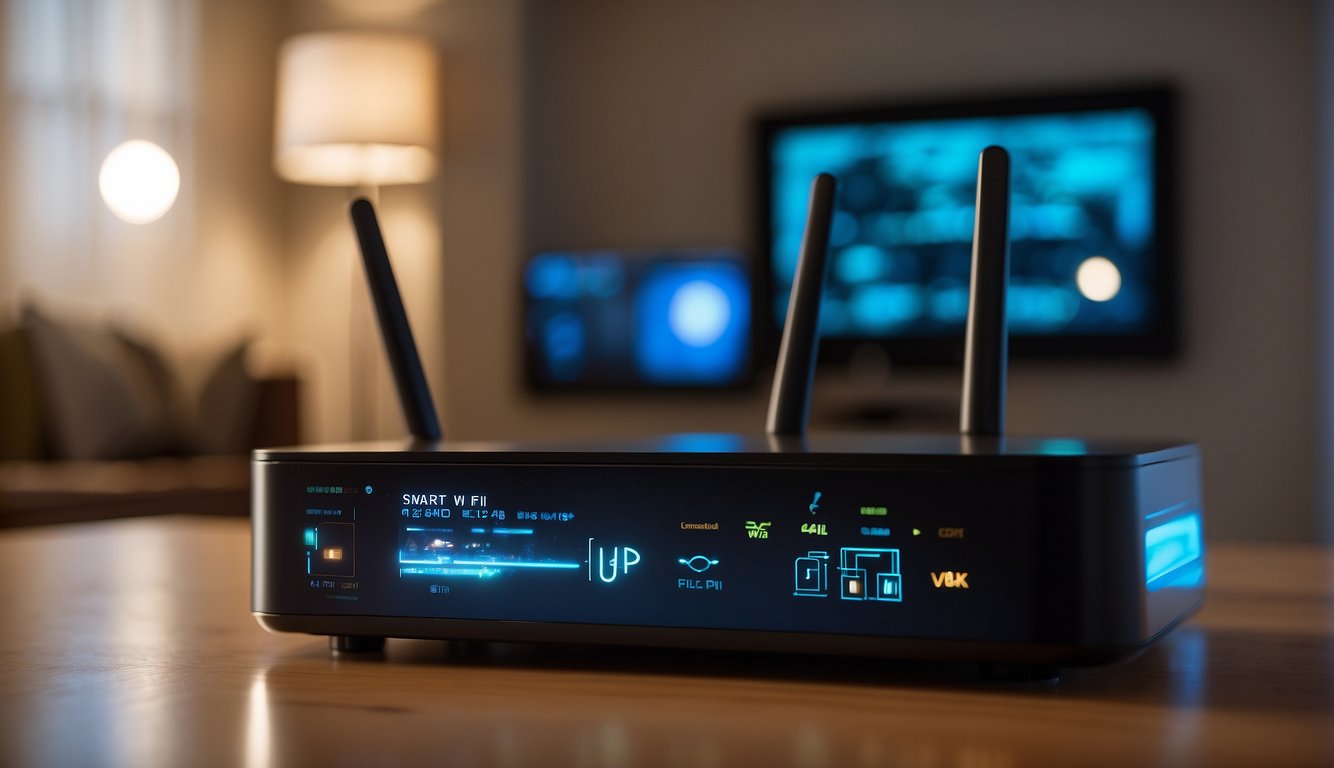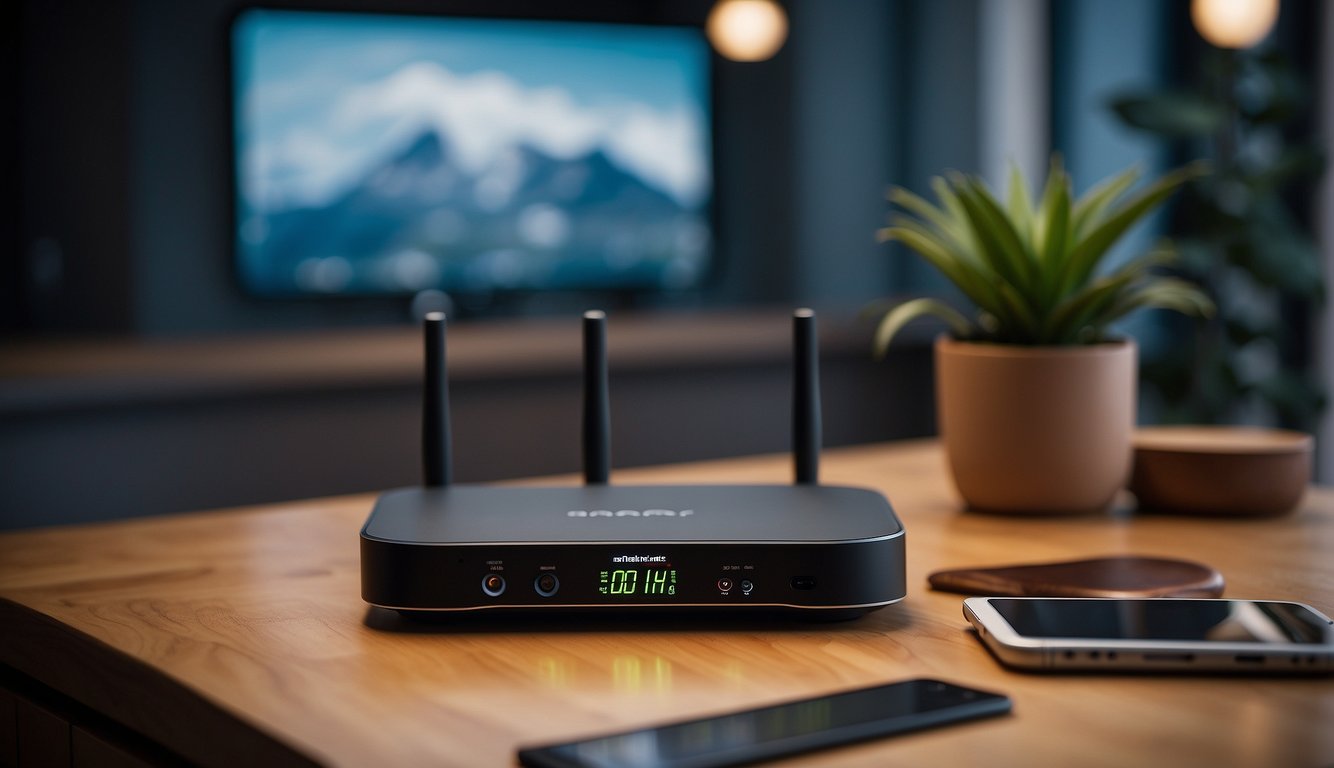Ever find yourself scratching your head at the term “smart Wi-Fi” and wondering what’s so smart about it? Well, it’s all about taking your wireless experience up a notch—or several.
Imagine not having to play musical chairs at home just to get better Wi-Fi coverage or constantly fiddle with your router settings. That’s the kind of convenience smart Wi-Fi brings to the table.

Smart Wi-Fi, sometimes called intelligent Wi-Fi, is a step up from traditional wireless technology. It’s designed to automatically adjust settings like signal strength and channel selection in real-time, which means it can improve your connection without you lifting a finger.
Plus, it can handle a slew of your gadgets at once, juggling your smart TV, phone, and laptop while keeping connections smooth.
Exploring Smart Wi-Fi

When you dive into Smart Wi-Fi, you’re looking at more than just a basic internet connection. It’s about taking your router’s capabilities to the next level with better coverage, faster speeds, and a more secure network.
Defining Smart Wi-Fi
Smart Wi-Fi, at its core, is like giving your router a brain upgrade. It’s designed to provide you with a consistent and reliable internet experience.
Unlike traditional Wi-Fi, which might offer a static and sometimes spotty connection, Smart Wi-Fi is all about intelligent management of your network. This means it efficiently handles how your devices connect and how the internet access is distributed in your home or office.
How Smart Wi-Fi Works
So, how does Smart Wi-Fi pull this off?
First off, these routers operate on both 2.4 GHz and 5 GHz frequencies. The 2.4 GHz offers wider coverage, while the 5 GHz delivers higher speeds.
A Smart Wi-Fi router uses these frequencies in separate bands, allowing for not just one access point, but a mesh network that blankets every corner of your space.
Here’s a breakdown of how a smart system optimizes your Wi-Fi:
- Automatic Frequency Adjustment: It moves your devices between frequencies based on usage patterns and interference, giving them the best possible signal.
- Enhanced Network Security: Smart Wi-Fi routers often come with WPA3 encryption, adding a strong layer of protection for your online activities.
- Device Prioritization: Your router can prioritize bandwidth to certain devices, like your 4K streaming TV or your work laptop during a video call.
With a Smart Wi-Fi router, your smartphones, laptops, and other smart devices get a stable and swift connection no matter where you are at home. And with the ability to manage your network through an app, you’re always in control, ensuring that your internet isn’t just smart, but also user-friendly.
Advantages of Smart Wi-Fi
Smart Wi-Fi isn’t just about connecting to the internet. It’s a game-changer in terms of performance, security, and how your devices talk to each other. Now, let’s break down the benefits you’ll enjoy.
Enhanced Performance
When you tap into Smart Wi-Fi, you’re signing up for top-notch speed and efficiency.
Your smart router is designed to allocate bandwidth judiciously, ensuring you get the speed you need when you need it.
With dual-band capabilities, it harnesses both 2.4 GHz and 5 GHz frequencies, dynamically switching to maintain peak performance with minimal latency.
Especially during activities like 4K video streaming or intense gaming sessions, quality of service (QoS) features prioritize your traffic to keep things smooth.
Better Security and Control
The strength of your Wi-Fi isn’t just measured in megabits per second. It’s also in how safe it keeps your data.
Smart Wi-Fi steps up with advanced encryption and the power to monitor devices on your network.
Think of having parental controls at your fingertips—managing not just when your kids are online but what they can access. Better security and control mean peace of mind knowing your digital domain is guarded.
Seamless Integration with Smart Home Devices
Your Smart Wi-Fi is the unsung hero in the smart home era. It’s all about seamless integration with your smart devices—from security cameras to video doorbells.
Your smart router is the maestro, cueing each device at just the right time, and making sure your connectivity is as smart as the devices themselves.
A stable and reliable network is key here, and Smart Wi-Fi ensures each smart device performs optimally, without you having to lift a finger.
Components of Smart Wi-Fi Systems

To get the most out of your smart home, understanding the components of Smart Wi-Fi systems is key. These systems harness technologies that provide faster, more stable connections for your devices.
Mesh Network
A mesh network is like a team where each player has each other’s back. Multiple access points work together to blanket your home with Wi-Fi, covering those tricky nooks and crannies.
It’s a game-changer in smart home tech, ensuring that your smart plugs, Nest thermostats, or any IoT device stay connected without a hitch, whether they use 2.4 GHz, 5 GHz, or even 6 GHz frequencies.
Dual-Band and Tri-Band Routers
Your router can be a multitasker, too. Dual-band routers juggle two frequencies: 2.4 GHz and 5 GHz.
Going a step further, tri-band routers add another 5 GHz band into the mix for even less congestion and more space for your devices to connect. It’s especially handy for bandwidth-hungry devices like the ones streaming 4K videos or tapping into Wi-Fi 6 capabilities.
Software and Applications
Consider software and applications the brains of the operation. They manage your network, using technologies like MU-MIMO and OFDMA to ensure efficient data streaming.
Advanced systems might feature Wi-Fi 6E with enhanced capacity for your ever-growing collection of gadgets. They even include intuitive apps that let you handle your Eero system or check your router’s health with just a few taps on your smartphone.
Optimizing Home Wi-Fi
Your home Wi-Fi network is like the digital highway for your internet. Ensuring it’s optimized means smoother streaming, faster speeds, and a more reliable connection for all your devices. Here’s how you can tune your wireless technology for peak performance.
Placement and Setup
Place your smart Wi-Fi router in a central location to expand signal coverage throughout your home.
Walls and large objects can cause interference, so keep the area around your router clear. Elevating your router off the floor can also improve signal strength.
Aim to avoid placing it near metal objects and appliances that emit electromagnetic waves. For homes with multiple floors, a central spot on the first floor, or even ceiling mounting, might give you the best spread of signal.
Managing Connectivity for Multiple Devices
To keep your Wi-Fi network speedy and responsive, especially when connecting multiple devices like smartphones, laptops, and smart TVs, understand the importance of bandwidth.
Modern smart Wi-Fi routers can operate on multiple frequency bands, offering separate networks like 2.4 GHz for longer range and compatibility, and 5 GHz for faster speeds at closer distances.
- 2.4 GHz
- Better range
- Good for browsing and emails
- Prone to interference
- 5 GHz
- Faster speed
- Ideal for streaming and gaming
- Shorter range
With a smart router, your devices can automatically switch to the best band based on their needs and location, optimizing your internet connection. Some routers also allow you to prioritize traffic to high-need devices, ensuring your work laptop gets precedence over other less urgent Wi-Fi demands.
The Future of Smart Wi-Fi

As you look towards the future, consider how smart Wi-Fi will evolve with advanced technologies enhancing not only speed but also security and connectivity for an ever-growing number of devices.
Emerging Wi-Fi Technologies
Imagine your Wi-Fi not just faster but smarter, with smart routers that can seamlessly manage your network capacity to handle all your devices.
The fastest protocols on the horizon, like Wi-Fi 7, are gearing up to use higher frequencies and wider channels.
What this means for your smartest and future-proof networking experience is a dual-band router that can operate efficiently on both 2.4 GHz and 5 GHz bands, offering you greater flexibility and less unpredictable performance issues.
One notable advancement is Intelligent Device Monitoring, a feature that continually analyzes the demands of each device.
This ensures your laptop or smart fridge gets exactly the bandwidth it needs without a hitch.
Anticipate a partnership between your internet service provider and your router to be more dynamic, smartly adjusting to your usage patterns and exterior network conditions.
Preparing for IoT Expansion
The number of devices that you’ll want to connect to your Wi-Fi network is only going to grow.
Your smart home ecosystem relies on a robust Wi-Fi network that can expand and adapt.
To stay ahead, smart routers are now evolving to incorporate malware protection and enhanced cybersecurity measures to safeguard each of your intelligent endpoints.
To support this IoT expansion, you’re going to want a Wi-Fi setup that can handle an ever-increasing load without sacrificing speed or stability.
That’s where advanced dual-band routers come in handy. They offer a dedicated frequency for your IoT devices, leaving other bands free for high-bandwidth activities like streaming or gaming.
It’s not only about the number of devices but how effectively your Wi-Fi can juggle them all. This makes network capacity an essential factor in your smart Wi-Fi’s future.

